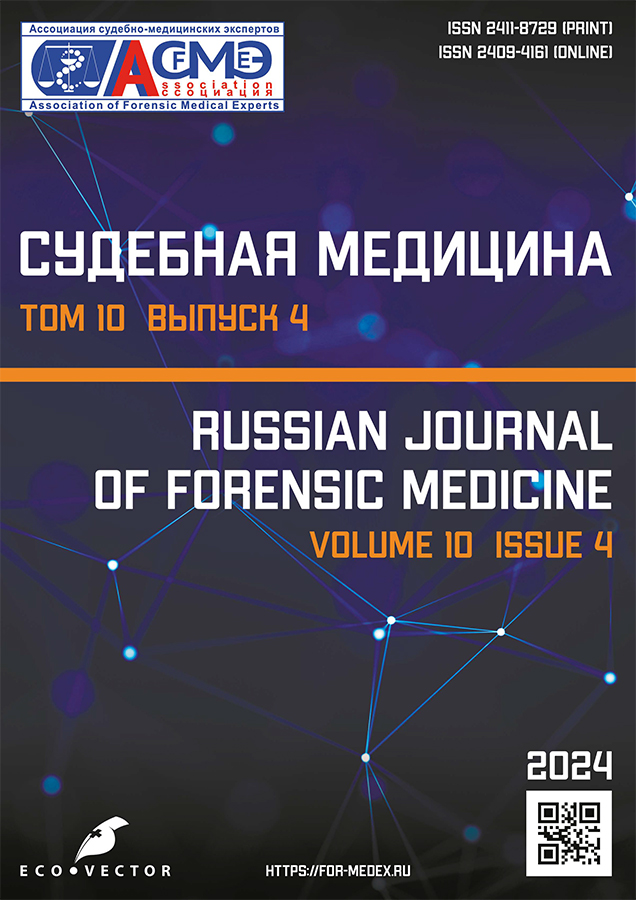头部损伤特征与军事冲突性质的关系
- 作者: Kislov M.А.1, Barinov E.K.2, Akulinichev E.А.3, Zotkin D.A.3
-
隶属关系:
- The Russian National Research Medical University named after N.I. Pirogov
- Russian University of Medicine
- The First Sechenov Moscow State Medical University
- 期: 卷 10, 编号 4 (2024)
- 页面: 566-577
- 栏目: 科学评论
- ##submission.dateSubmitted##: 15.05.2024
- ##submission.dateAccepted##: 01.10.2024
- ##submission.datePublished##: 05.12.2024
- URL: https://for-medex.ru/jour/article/view/16145
- DOI: https://doi.org/10.17816/fm16145
- ID: 16145
如何引用文章
详细
头部损伤是和平时期和战争时期最严重、最复杂的创伤之一。本文研究了在多个大规模军事冲突中发生的头部损伤,并探讨了伤害部位、创伤特征与作战战术、所使用武器及地形之间的关联性。鉴于当前特殊军事行动的背景,这一分析具有重要意义,可用于个人防护装备的研发,以及战地医院中头部创伤治疗策略的制定。
本文引用了科学与专业文献,相关文献通过eLibrary、ResearchGate、CyberLeninka和PubMed数据库检索获得。在研究过程中,作者采用统计学分析、系统结构分析、描述性分析、比较、总结以及假设建构等方法。文章对叙利亚阿拉伯共和国内战(Syrian Civil War)、“伊拉克自由”(Operation Iraqi Freedom)和“持久自由”(Operation Enduring Freedom)军事行动进行了分析,并提取了损伤的平均值,将其按照受损结构类型分类展示以增强可视化效果。研究发现,头部损伤的特征因军事冲突性质不同而显著变化。然而,无论冲突类型如何,下颌,上颌,眼眶和鼻部始终是头部最易受伤的区域。
本文为医学研究领域提供了重要见解,对军医以及从事个人防护装备研发和改进的科研机构和工程技术单位的专业人员具有参考价值。
全文:
作者简介
Maksim А. Kislov
The Russian National Research Medical University named after N.I. Pirogov
Email: kislov@sechenov.ru
ORCID iD: 0000-0002-9303-7640
SPIN 代码: 3620-8930
MD, Dr. Sci. (Medicine), Assistant Professor
俄罗斯联邦, MoscowEvgeny Kh. Barinov
Russian University of Medicine
Email: ev.barinov@mail.ru
ORCID iD: 0000-0003-4236-4219
SPIN 代码: 2112-4568
MD, Dr. Sci (Medicine), Professor
俄罗斯联邦, MoscowEgor А. Akulinichev
The First Sechenov Moscow State Medical University
Email: egor40rus@icloud.com
ORCID iD: 0009-0002-2142-151X
俄罗斯联邦, Moscow
Dmitriy A. Zotkin
The First Sechenov Moscow State Medical University
编辑信件的主要联系方式.
Email: zotkin.dmitriy.83@mail.ru
ORCID iD: 0000-0002-2419-5952
SPIN 代码: 9263-0002
俄罗斯联邦, Moscow
参考
- Trotsenko KА. Fighting in Syria: Furthering combined-arms combat and operation methods or a special case? Voyennaya mysl = Military thought. 2020;(12):31–48. EDN: NLBUOM
- Isakov VD, Babakhanyan RV, Matyshev LL, et al. Forensic medical expertise of explosive trauma. Saint Petersburg; 1997. 120 р. (In Russ.)
- Nechaev EA, Gritsanov AI, Fomin NF, Minnullin IP. Minno-explosive trauma. Saint Petersburg: Al'd; 1994. 488 р. (In Russ.)
- Popov VL. Explosion. Forensic and medical aspects: A guide for experts. Saint Petersburg: Yuridicheskii tsentr; 2019. 296 с. (In Russ.)
- Popov VL. Certain theoretical-methodological problems of forensic medical expertise of the blast injury. Sudebno-meditsinskaia ekspertiza = Forensic medical expertise. 2015;(4):4–10. EDN: UGWJWP
- Popov VL, Tiurin MV, Makarov II, Fradkina NA. The current state and prospects of the development of forensic medical expertise of the blast injury. Sudebno-meditsinskaia ekspertiza = Forensic medical expertise. 2013;(3):25–30. EDN: QCNBPR
- Forensic medicine and forensic medical expertise: National manual. Ed. by Y.I. Pigolkin. Moscow: GEOTAR-Media; 2014. Р. 307–328. (In Russ.)
- Tomilin VV, Pashinyan GA. Manual on forensic medicine. Moscow: Meditsina; 2001. 576 р. (In Russ.)
- Fradkina NA, Kovalev AV, Makarov II. Peculiarities of forensic medical reconstruction of the mechanism of injuries in numerous victims of the explosion of a high-capacity blasting device. Sudebno-meditsinskaia ekspertiza = Forensic medical expertise. 2013;(2):4–6. EDN: PYSSKJ
- Kislov MA, Makarov IY, Leonov SV, et al. The current state of the issue on explosive injury. Sudebno-meditsinskaia ekspertiza = Forensic medical expertise. 2021;(4):68–72. EDN: KKOANH doi: 10.17116/sudmed20216404168
- Molchanov VI. Forensic medical examination of explosion injuries. Leningrad: Voenno-meditsinskaya akademiya im. S.M. Kirova; 1962. 18 р. (In Russ.)
- Arlı C, Özkan M, Karakuş A. Incidence, etiology, and patterns of maxillofacial traumas in Syrian patients in Hatay, Turkey: A 3-year retrospective study. Ulus Travma Acil Cerrahi Derg. 2019;25(1):29–33. doi: 10.5505/tjtes.2018.16243
- Ucak M. Shrapnel injuries on regions of head and neck in Syrian war. J Craniofac Surg. 2020;31(5):1191–1195. doi: 10.1097/SCS.0000000000006345
- Ucak M. Incidence and severity of maxillofacial injuries during the Syrian civil war in Syrian soldiers and civilians. J Craniofac Surg. 2019;30(4):992–995. doi: 10.1097/SCS.0000000000005440
- Neubauer DC, Camacho M, O'Reilly EB, et al. The new face of war: Craniofacial injuries from operation inherent resolve. J Trauma Acute Care Surg. 2022;93(2S, Suppl. 1):S49–S55. EDN: XOSWMR doi: 10.1097/TA.0000000000003700
- Hanafi I, Munder E, Ahmad S, et al. War-related traumatic brain injuries during the Syrian armed conflict in Damascus 2014–2017: A cohort study and a literature review. BMC Emerg Med. 2023;23(1):35. EDN: MBDTRS doi: 10.1186/s12873-023-00799-6
- Şimşek KB, Dokur M, Uysal E, et al. Characteristics of the injuries of Syrian refugees sustained during the civil war. Ulus Travma Acil Cerrahi Derg. 2017;23(3):199–206. doi: 10.5505/tjtes.2016.95525
- Valetsky OV, Girin AV, Markin AV, Neelov VM. Lessons of Iraq. Tactics, strategy and technique in the Iraqi wars of the USA. Moscow: Izdatel' Vorob'ev A.V.; 2015. 212 р. (In Russ.)
- Valetsky OV, Neelov VM. Features of combat operations in Afghanistan (2001–2015). A brief essay. Moscow: Izdatel' Vorob'ev A.V.; 2015. 88 р. (In Russ.)
- Hauer T, Huschitt N, Kulla M, et al. [Bullet and shrapnel injuries in the face and neck regions. Current aspects of wound ballistics. (In German)]. HNO. 2011;59(8):752–764. doi: 10.1007/s00106-011-2365-1
- Brennan J. Head and neck trauma in Iraq and Afghanistan: Different war, different surgery, lessons learned. Laryngoscope. 2013;123(10):2411–2417. doi: 10.1002/lary.24096
- Keller MW, Han PP, Galarneau MR, Gaball CW. Characteristics of maxillofacial injuries and safety of in-theater facial fracture repair in severe combat trauma. Mil Med. 2015;180(3):315–320. doi: 10.7205/MILMED-D-14-00345
- Lew TA, Walker JA, Wenke JC, et al. Characterization of craniomaxillofacial battle injuries sustained by United States service members in the current conflicts of Iraq and Afghanistan. J Oral Maxillofac Surg. 2010;68(1):3–7. doi: 10.1016/j.joms.2009.06.006
- Breeze J, Gibbons AJ, Shieff C, et al. Combat-related craniofacial and cervical injuries: A 5-year review from the British military. J Trauma. 2011;71(1):108–113. doi: 10.1097/TA.0b013e318203304a
- Stewart SK, Pearce AP, Clasper JC. Fatal head and neck injuries in military underbody blast casualties. J R Army Med Corps. 2019;165(1):18–21. doi: 10.1136/jramc-2018-000942
- Breeze J, Gensheimer W, DuBose JJ. Combat facial fractures sustained during operation resolute support and operation freedom's sentinel in Afghanistan. Mil Med. 2020;185(9-10):414–416. doi: 10.1093/milmed/usaa159
补充文件













